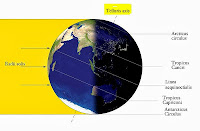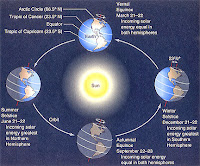The March Equinox fell on 20 March this year. The Earth spins on its
axis at an angle to the plain of the Solar System. This means that the
poles of the Earth do not remain at 90° to the Sun, but rather the
northern pole is tilted towards the Sun for six months of the year (the
northern summer), and the southern pole for the other six months (the
southern summer). This means that twice a year neither pole is inclined
towards the Sun, on days known as the equinoxes.
The tilt of the Earth relative to the Sun at the planet's equinoxes and solstices. Astronomy Group/University of St Andrews.
The equinoxes fall each year in March and September, with the March
Equinox being the Spring (or Vernal) Equinox in the Northern Hemisphere
and the Autumn Equinox in the Southern Hemisphere, while the September
Equinox is the Autumn Equinox in the Northern Hemisphere and the Spring
Equinox in the Southern Hemisphere. On these two days the day and night
are both exactly twelve hours long at every point on the planet, the
only days on which this happens.
See also...
 The 2015 December Solstice. The December (or Southern) Solstice this year falls on Tuesday 22 December,
when the Sun is at its southernmost point in the sky. This is the
shortest day of the year in the Northern Hemisphere, where it is known
as the Winter Solstice and the longest day in...
The 2015 December Solstice. The December (or Southern) Solstice this year falls on Tuesday 22 December,
when the Sun is at its southernmost point in the sky. This is the
shortest day of the year in the Northern Hemisphere, where it is known
as the Winter Solstice and the longest day in... Eclipse of the Supermoon. A
total Lunar Eclipse will occur on 28 September 2015, starting at about
ten minutes past midnight GMT. It will be visible across much of Western
Europe and...
Eclipse of the Supermoon. A
total Lunar Eclipse will occur on 28 September 2015, starting at about
ten minutes past midnight GMT. It will be visible across much of Western
Europe and... September Equinox 2015. The
September Equinox will fall on Friday 23 September 2015, when the day
and night will be of equal length in both of the Earth's hemispheres. The
Earth's seasons are driven by the tilt of the planet, but the planet
does not, as is generally assumed, tilt back and forth over the course
of a year. Rather it remains at a constant angle
of 23½° to the plane of its orbit throughout the year...
September Equinox 2015. The
September Equinox will fall on Friday 23 September 2015, when the day
and night will be of equal length in both of the Earth's hemispheres. The
Earth's seasons are driven by the tilt of the planet, but the planet
does not, as is generally assumed, tilt back and forth over the course
of a year. Rather it remains at a constant angle
of 23½° to the plane of its orbit throughout the year...
